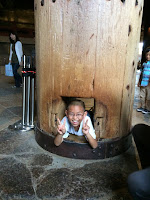 |
A fox statue standing
besides the building
Left
|
 |
A fox statue standing
besides the building
Right
|
The Fushimi Inari Shrine 伏见稻荷大社 was built in February, 711. It is the most
important shrine dedicated to the god of rice. Foxes are believed to be the
messengers, so the fox statues are everywhere. It is the home to 10,000 torii gates 千本鸟居 (the orange gate). The torii gates are built along the trail behind its
main buildings. All gates and buildings were restored in 2011 and bright red color came back. The trail is four kilometers long. It leads into the forest of
the sacred Mount Inari. Follow the torii gates, people can hike to the 233 meter
high mountaintop. You will get a beautiful city view of Kyoto from high up. If
you are lucky enough, go there during the golden hours to see the sunlight
hit the vermilion gates. It was so pretty.
 |
| Kyoto Train Station |
 |
| JR Train to Nara |
Saying farewell to the ancient capital Kyoto 京都, we rode a JR
Train to another ancient capital Nara 奈良. Actually it is the first capital of
Japan, before the capital moved to Kyoto. Nara was in rain when we arrived. The
city service center was nice enough to provide all visitors with free umbrellas.
The Nara Park 奈良公园 is very close by the Nara Train Station. After 20 minutes of walk,
we started seeing deer. There are deer everywhere. Even the city symbol is
deer. I was for sure that I am in Nara Park already.
  |
| Doe Park 鹿苑 |
 |
| Feeding the doe at the Doe Park 鹿苑 |
|
|
 |
| Picture at Doe Park |
 |
| Deer on the street |
We went to the Doe Park 奈良鹿苑. It was full of doe with their
mom but where were the daddies? The males are sent out. On the way to the park there is a street called
Deer Aware Road 鹿出没. People believe that the deer are the
god’s messengers. So the deer were allowed to roam Nara Park freely. The park provides acorns to feed the little ones. We also bought some grass balls. The deer mom ate most of them. Only once did the baby got it.
 |
| Deer at Kasuga Taisha Shrine 春日大社 |
  |
| Entering Kasuga Taisha Shrine 春日大社 |
  |
The stone lanterns along the way to Kasuga Taisha Shrine 春日大社
  |
| The bronze and gold lanterns hanging inside the shrine |
|
 |
| Deer statue squirts out water to clean hands |
Here we come, Kasuga Taisha Shrine 春日大社! Deer and stone lanterns can be found everywhere. There is also a deer statue that spews out water. The water is used to clean hands. The shrine is well known for its lanterns. The lanterns are made of all sorts of things such as stone, bronze, and even gold! There are swelling amounts of lanterns. The 3,000 stone lanterns are just a little bit. The festivals were all hosted there because all the lanterns were lit up while getting dark. Its night is always as bright as daytime. Kasuga Taisha Shrine has not been touched since Nara was capital. Everything we saw today was the original!
  |
| 若草山 |
  |
| Left: hand wash at 二月堂, Right: 东大寺钟楼 |
  |
手向山神社
|
 |
The entrance of the Great Buddha Hall
the Todaiji Temple
|


















































No comments:
Post a Comment